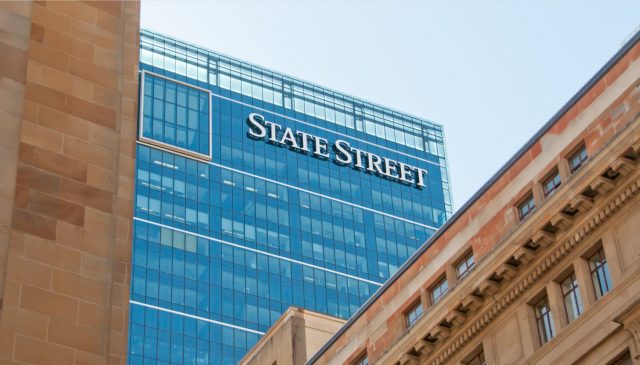There’s no shortage of breathless hype about blockchain.
What’s harder to find is a sober and nuanced discussion of the technology’s merits and drawbacks for a particular use case. For such a perspective, it can help to talk to different people at the same company who have been studying the matter and reached divergent conclusions.
It’s not a secret that State Street, the giant U.S. custody bank, is looking to streamline the complex business of securities lending using blockchain. A decades-old industry, securities finance today is a continual dance of manual reconciliation, involving a string of market participants and lending parameters, all of which has become even more complicated since the 2008 financial crash.
In theory, distributed ledger technology (DLT), with its shared view of the truth, removes the need for multiple processes and lots of intermediary players.
But it was never going to be a simple transition – and that’s one thing at least that executives from different parts of the bank can agree on.
In terms of how peer-to-peer securities lending could be deployed, people from the technology architecture and product teams are bullish about what they consider an inevitable change.
From the product development side, Nick Delikaris, head of global trading and algorithmic strategies, said that “the whole industry” is looking at a peer-to-peer version of securities lending, and blockchain based solutions are definitely on the cards.
He also acknowledged the scale of the challenge, telling CoinDesk,
“It’s not an on-off button, like you can wake tomorrow and be doing everything peer-to-peer.”
Delikaris said he expects to see a mix of products and services. “Different counterparties will have different flavors, and to start with some of this tech may actually make things harder,” he said.
“I think that’s what we are going through right this second. But at the end of the day, we will have a better industry set up.”
Meanwhile, the pragmatists in the front office, who perhaps take more of a legacy marketplace position, remain wary of such a transformation.
Doug Brown, head of alternative financing solutions at State Street, said he sees potential value in using blockchain to enable P2P lending of securities, but cautioned that most of the market isn’t ready for it.
“If you look at that marketplace and the people who borrow securities, there are very few institutions that have the technology or the operational infrastructure in place to do that themselves today,” he said.
Brown added that “there is a real question about whether it’s worth their time to build that infrastructure, the cost to do it, the staffing to do it – or whether the model they are using today is efficient enough.”
Pros and cons
Taking a step back, “peer-to-peer” lending in this context means a client who wants to lend securities (typically a large mutual fund or pension plan) directly faces the borrower (normally a hedge fund), as opposed to having a broker-dealer in the middle managing the whole operation.
State Street has a panoramic view of the securities lending landscape; the bank has two components under its roof that most people don’t have, explained Delikaris.
“We have an arm called enhanced custody, which is basically akin to a prime broker,” i.e. a provider of specialized services to hedge funds, he said.
“We also have the biggest agent lender in the world,” he added, referring to State Street’s business of lending securities to institutions on behalf of its clients.
This means that testing out a blockchain idea – which State Street began doing in 2016 with a proof of concept (PoC) for digital tokens to post collateral – has evolved to a point where the bank is mapping out the entire securities financing ecosystem for potential transformation.
And this, in turn, has led to markedly different views inside the bank on the pros and cons.
From his front-office perspective, Brown conceded a P2P model might make it a little cheaper to borrow securities, while State Street’s traditional lending clients might make a bit more on the transaction.
But he also reeled off a list of challenges, and in so doing told a familiar story about the real benefits intermediaries and brokers bring to a market.
Prime brokers, for example, manage all aspects of liquidity and are charged with finding substitute collateral when required to do so. In addition, going P2P without anyone in between means counterparties would need to do credit due diligence on each other.
Plus there would no longer be borrower default indemnification, which is pretty much expected across the industry, noted Brown. In other words, if the borrower in a P2P transaction fails to return the borrowed assets, the lender is out of luck, whereas in today’s market an intermediary like State Street will cover the loss.
“A P2P model, where everybody faces each other and negotiates contracts, where the protection is gone and both parties now need credit teams, would likely not be a broad industry solution,” said Brown.
“That model might work for a small subset of institutions. But if you only had a small number of institutions participating I think it might be challenging to convince people there was enough liquidity to really move that market in a large way,” he said.
Delikaris took on board the very real concerns of his colleague, agreeing “this can’t simply be done in a lab” but involves talking to clients to find out “what keeps them up at night.”
However, he defended a P2P model which he said could be offered to lenders with an appetite for more risk, who might not care about the indemnity – adding that things could be priced differently because of that.
“My own personal feeling is that if some things get transformed because of this technology I think what you’ll see are other products and services that will come and piggyback off that to help where those issues arise,” he said.
Evolution, not revolution
Meanwhile, other banks are forging ahead with securities lending using blockchain, but like State Street, they expect a long transition period.
Back in March this year, ING and Credit Suisse completed a live securities lending transaction using a collateral-lending blockchain application co-developed by HQLAx and R3.
Herve Francois, blockchain initiative lead at ING, said that for now his bank is “leveraging the existing infrastructure of tri-party agents and custodians in order to go to production faster, as this constitutes a legal framework by itself.”
Francois acknowledged that market participants might be left with missing services if they moved to a P2P model, and in the event may need to outsource to the current intermediaries.
“That could be a way for those actors to still play a role in the short- to medium-term,” he said. “It’s a step in the blockchain evolution which in the long run should be able to disintermediate them.”
Guido Stroemer, CEO of HQLAx, which is focused on tokenizing baskets of securities to help bank treasurers manage and transfer liquidity better, agreed the legacy marketplace requires many operational stages to be carried out in a well-established manner
Going forward, Stroemer said some assets lend themselves to DLT better than others, with securities first, then cash, and maybe gold.
“Successful use cases will only thrive in the real world when they have relatively low barriers to entry,” said Stroemer, concluding:
“Anything that requires a market user to go through a ‘big bang’ change has no chance of creating market wide adoption.”
State Street image via Shutterstock
The leader in blockchain news, CoinDesk is a media outlet that strives for the highest journalistic standards and abides by a strict set of editorial policies. CoinDesk is an independent operating subsidiary of Digital Currency Group, which invests in cryptocurrencies and blockchain startups.




